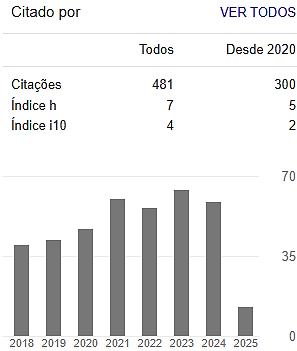CORREÇÃO AUTOMATIZADA DE QUESTÕES DISSERTATIVAS UTILIZANDO MEDIDAS DE SIMILARIDADE E PROCESSAMENTO DE LINGUAGEM NATURAL
DOI:
https://doi.org/10.5747/ce.2023.v15.e399Palavras-chave:
PLN, correção automática, questões dissertativasResumo
O Brasil tem vivenciado na última década, um grande aumento da procura pelo Ensino a Distância, com o advento da pandemia, essa tendência ficou ainda mais acentuada com a adaptação forçada pela realidade pandêmica aos professores, embora difícil inicialmente, contribuiu para uma visão clara de como ferramentas tecnológicas podem proporcionar um auxílio maior na prática de suas atividades pedagógicas e de ensino aos discentes, auxiliando e prevenindo avaliações incorretas durante um período de estresse físico ou emocional, ao mesmo passo que otimizaria o tempo dedicado a sua atividade profissional. Utilizando técnicas de Processamento de Linguagem Natural para obter a representação de conhecimento a partir resposta pré-processado do aluno, foi possível obter uma acurácia entre 50 e 77 por cento quando comparado a nota atribuída por um avaliador humano e o sistema computacional em si, bastando que o avaliador forneça ao sistema uma resposta de referência ou um conjunto de palavras-chave ou diversas amostras de cada questão daquilo que se espera que esteja abordado dentro da resposta avaliada.
Downloads
Referências
ALBAWI, S.; MOHAMMED, T. A.; AL-ZAWI, S. Understanding of a convolutional neural network. In: INTERNATIONALCONFERENCE ON ENGINEERING AND TECHNOLOGY (ICET). 2017. https://doi.org/10.1109/ICEngTechnol.2017.8308186.
ALI, Z. A simple Word2vec tutorial Medium, 7 jan. 2019. Disponível em: https://medium.com/@zafaralibagh6/a-simple-word2vec-tutorial-61e64e38a6a1. Acesso em: 24 abr. 2022.
BRYANT, C.; BRISCOE, T. Language model based grammatical error correction without annotated training data. In: WORKSHOP ON INNOVATIVE USE OF NLP FOR BUILDING EDUCATIONAL APPLICATIONS. 13., 2018. New Orleans, Louisiana. Proceedings [...]. New Orleans: Association for Computational Linguistics,2018. p. 247-253. https://doi.org/10.18653/v1/W18-0529
CARVALHO, M. J. S.; NEVADO, R. A.; MENEZES, C. S. Arquiteturas pedagógicas para educação à distância: concepções e suporte telemático. In: SIMPÓSIO BRASILEIRO DE INFORMÁTICA NA EDUCAÇÃO-SBIE, 16., 2005, Juiz de Fora. Anais [...]. Juiz de Fora, 2005. p. 351-360.
COHEN, D. Precalculus: A Problems-Oriented Approach , Cengage Learning,2004.
COSTA, L.; OLIVEIRA, E. H T.; CASTRO JÚNIOR, A. Corretor Automático de Redações em Língua Portuguesa: um mapeamento sistemático de literatura. In: SIMPÓSIO BRASILEIRO DE INFORMÁTICA NA EDUCAÇÃO, 31., 2020. Porto Alegre, Anais [...]. Porto Alegre: Sociedade Brasileira de Computação, 2020. p. 1403-1412. DOI: https://doi.org/10.5753/cbie.sbie.2020.1403.
NIST. COSINE DISTANCE, COSINE SIMILARITY, ANGULAR COSINE DISTANCE, ANGULAR COSINE SIMILARITY, 2017. Disponível em: https://www.itl.nist.gov/div898/software/dataplot/refman2/auxillar/cosdist.htm. Acesso em: 17 abr. 2022.
DERTAT, A. Applied Deep Learning - Part 4: Convolutional Neural Networks. Towards Data Science, nov. 2017. Disponível em: https://towardsdatascience.com/applied-deep-learning-part-4-convolutional-neural-networks-584bc134c1e2. Acesso em: 11 dez. 2022.
FEPESP. Hora-atividade. São Paulo: FEPESP, 2018. Disponível em: http://fepesp.org.br/noticia/hora-atividade/. Acesso em: 10 out. 2021.
HU, Y.; JING, X.; KO, Y.; RAYZ, J. T. Misspelling Correction with Pre-trained Contextual Language Model. In: INTERNATIONAL CONFERENCE ON COGNITIVE INFORMATICS & COGNITIVE COMPUTING (ICCI* CC). 19., IEEE, 2020. p. 144-149. https://doi.org/10.1109/ICCICC50026.2020.9450253
JONES, K. S. A statistical interpretation of term specificity and its application in retrieval. Journal of documentation, 1972.
LANDAUER, T.; LAHAM, D.; FOLTZ, P. Learning human-like knowledge by singular value decomposition: A progress report. In: CONFERENCE ON ADVANCES IN NEURAL INFORMATION PROCESSING. NIPS’97. 1997. Proceedings [...]. 1997, v. 10. Disponível em: chrome-extension://efaidnbmnnnibpcajpcglclefindmkaj/https://proceedings.neurips.cc/paper_files/paper/1997/file/cec6f62cfb44b1be110b7bf70c8362d8-Paper.pdf. Acesso em: 30 jun. 2023.
LÓPEZ-HERNÁNDEZ, J., ALMELA, Á., VALENCIA-GARCÍA, R. Automatic Spelling Detection and Correction in the Medical Domain: A Systematic Literature Review. In: VALENCIA-GARCÍA, R. et al. (eds.) Technologies and Innovation. CITI 2019. Communications in Computer and Information Science. [S.l.]: Springer, Cham, 2019, v.1124. https://doi.org/10.1007/978-3-030-34989-9_8
MIKOLOV, T. et al. Efficient Estimation of Word Representations in Vector Space. arXiv:1301.3781 [cs], 6 set. 2013.
NAU, J.; HAENDCHEN FILHO, Aluizio; DAZZI, R. L. S. Identificação e avaliação automática da proposta de intervenção em textos dissertativos-argumentativos: uma revisão sistemática da literatura. In: COMPUTER ON THE BEACH, 10., 2019, Itajaí. Anais [...]. Itajaí, 2019. p. 493-501.
OMELIANCHUK, K.; ATRASEVYCH, V.; ARTEM, C.; SKURZHANSKYI, O. GECToR--Grammatical Error Correction: Tag, Not Rewrite. arXiv preprint arXiv:2005.12592, 2020. https://doi.org/10.18653/v1/2020.bea-1.16
PARISI, J. M. A remuneração da hora-atividade e dos períodos de janela na jornada de trabalho do docente. Trabalho de Conclusão de Curso (Graduação) - Faculdade de Direito, Universidade Federal do Rio Grande do Sul, Porto Alegre, 2017.
RAJARAMAN, A.; ULLMAN, J. D. Mining of massive datasets. [S.l.]: Cambridge University Press, 2011. https://doi.org/10.1017/CBO9781139058452
SANTOS, J. C. A. et al. Avaliação automática de questões discursivas usando LSA. 2016. Tese (Doutorado em Engenharia Elétrica) - Instituto de Tecnologia, Universidade Federal do Pará, Belém, 2016.Disponível em: http://repositorio.ufpa.br/jspui/handle/2011/7485. Acesso em: 30 jun. 2023.
SMITH, K. J. Precalculus: A functional approach to graphing and problem solving. [S. l.]: Jones & Bartlett Publishers, 2011.
SINGHAL, A. et al. Modern information retrieval: A brief overview. IEEE Data Eng. Bull., v. 24, n. 4, p. 35-43, 2001.
SIROTHEAU, S.; SANTOS, J.; FAVERO, E.; FREITAS, S. N. Avaliação Automática de respostas discursivas curtas baseado em três dimensões linguísticas. In:
CONGRESSO BRASILEIRO DE INFORMÁTICA NA EDUCAÇÃO, 8., SIMPÓSIO BRASILEIRO DE INFORMÁTICA NA EDUCAÇÃO, 30., 2019, Brasília. Anais [...]. Brasília: 2019. https://doi.org/10.5753/cbie.sbie.2019.1551
WIEMER-HASTINGS, P. Latent semantic analysis. In: INTERNATIONAL JOINT CONFERENCE ON ARTIFICIAL INTELLIGENCE. 16., 2004. Proceedings [..], 2004, p. 1-14.
VICARI, R. M. Tendências em inteligência artificial na educação no período de 2017 a 2030: sumário executivo. Porto Alegre: SENAI/RS, 2018.

